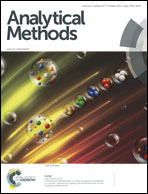A zero-background fluorescent probe for Hg2+ designed via the “covalent-assembly” principle†
Abstract
We herein report a novel fluorescent probe for Hg2+ based on the deprotection of 1,3-dithiolane, via the covalent assembly principle. Presence of Hg2+ triggers a cascade, which ultimately furnishes the push–pull backbone of a fluorescent dye, rendering a turn-on signal from a zero background and hence high detection sensitivity.


 Please wait while we load your content...
Please wait while we load your content...